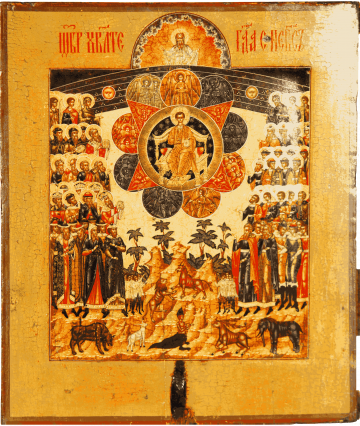Praise the Lord from Heaven
(Russia; nineteenth century)
Russia; nineteenth century; 35 x 39.6 cm
Iconography
Icons of this type are not particularly common. Psalms of praise are sung during the morning services both in the Eastern Church in the morning (morning prayers) and in the Western Church in the morning praises. The union of Psalms 148, 149 and 150 is very old and dates back to synagogue worship (first century liturgies). Despite this liturgical fact, icons of this type did not appear until the end of the fifteenth century in Greece, in the Balkans and in Russia, while in the sixteenth century they acquired a symbolic-didactic and dogmatic-allegorical significance. These kinds of compositions usually appeared in the form of murals, but also occasionally as portable icons painted on wood.
Description of the icon
The icon interprets Psalm 148 “Praise the Lord from Heaven.” The Lord of Hosts – Sabaoth is at the top of the icon in the middle of the inscription. He blesses the created world with both hands. The individual heavens below it are shown in the form of arched stripes (in the manner of a rainbow). The stars, the sun, the moon and the "waters", however, exceed them. Emanuel is sitting on the throne surrounded by the entire heavenly hierarchy, represented by nine choirs placed in circles, in the centre of the icon: Seraphim, Cherubim, Thrones - Dominions, Principalities, Powers - Forces, Archangels and Angels. The scene also includes four triangles depicting the evangelists, but not in a human form but in symbolic images - four living creatures, a winged man, a lion, a bull and an eagle, as described by the Prophet Ezekiel (1:10; 10, 14) or by the apostle Saint John (Rev. 4: 6-7). These four apocalyptic beings were later attributed to the Evangelists by Saints Irenaeus Lyon († 202) as their symbols. The symbol of the winged man belonged to Matthew, the eagle to Mark, the bull to Luke and the lion to John. St. Augustine († 430) did not agree, however, with Irenaeus and assigns Matthew the symbol of the lion, Mark of man, Luke of the bull, and John of the eagle. Saint Hieronym († 420) held a view that persists to this day, that the symbol of man refers to Matthew, the lion to Mark, the bull to Luke, and the eagle to John. Hieronym clarifies this arrangement of symbols by the fact that the Gospel of Matthew begins with the genealogy of Jesus Christ (symbol of man); the Gospel of Mark by a voice calling in the desert (symbol of the lion); the Gospel of Luke by the sacrifice of the high priest Zacharias in the temple (symbol of the bull) and the Gospel of John by the inaccessible heights of the Word (symbol of the eagle). St. Gregory the Great († 604) also agreed with the clarification of Hieronym, and also admits the clarification of the symbolic depictions of the evangelists with regard to Christ himself, who incarnated and assumed a human nature (symbol of man). He sacrificed himself for us (symbol of the bull), destroyed the shackles of death (symbol of the lion) and ascended to heaven (symbol of the eagle). Similarly, the Patriarch of Jerusalem, Saint Sophrony († 638), understood the lion as a symbol of Christ's rule and power, the bull as a symbol of Christ's priestly service, man as a symbol of Christ's incarnation and the eagle as a symbol of the descending power of the Holy Spirit.
There are crowds of saints of all status on both sides: apostles, prophets, ancestors, kings, the blissful, princes, young men, virgins and children, who all turn in prayer to Christ in the same way as can be seen in the icons of the Last Judgment. The consecrated Virgin Mary is to the right of Christ, in the left part of the icon, at the head of the crowd, and opposite her, to the left of Christ, St. John the Baptist, bringing the hosts of saints to Christ. This arrangement is strikingly reminiscent of the expanded version of the icon of Deésis - as a symbol of a prayer to God for all, begging for mercy and the forgiveness of sins at the Last Judgment for the people.
There is a terrestrial landscape, in the middle are “mountains and all the hills and the whole abyss” with Lebanese cedars, at the bottom of the icon. Animals move among them. The world of fauna is particularly diverse. There are known animals (goat, bear, deer), exotic (elephant, lion) as well as a fantastic world. All heavenly creation is united in peace and worship, subject to the general plan of the Creator.
The composition forms almost a cathedral. The crowds of all the creatures gather in the name of Christ. Eternal prayer, the unity of Heaven and Earth around the Saviour, are a sign of the coming Heavenly Kingdom, built according to the laws of Divine Wisdom. The composition of the icon can be considered an image of a renewed universe that has returned to paradise.
The icon, in artistic language, through symbols and colours, glorifies God as the Creator for all that he has done for people out of love. The author of the icon praises the perfection of the creative work, expressed in the diversity and harmony of the created world, which is a pre-image of the future – the eschatological world.


